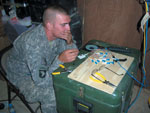Troops in Afghanistan Bridge Communications Gap
 |
| Pfc. Christopher Dubios, USA, terminates fiber as part of the fiber upgrade project at Forward Operating Base Gardez in Afghanistan. The 4th Brigade Combat Team’s Signal Company conducted the project in support of the 1-61 Cavalry. |
Sure and steady progress in communications in the Islamic Republic of Afghanistan has dramatically sped up the pace of coalition combat, security, governance and development operations throughout the country. Since 2001, telecommunications capabilities have leapt from the Stone Age into the 21st century, and military networks have been taught to talk to each other. From the tactical perspective, this progress is increasing shared situational awareness and boosting collaboration among nations.
Lt. Col. John Burger, USA, chief, Strategic Programs Branch, J-6, U.S. Central Command (CENTCOM), MacDill Air Force Base, Florida, explains that at the opening of operation Enduring Freedom, the U.S. services used the radios and networks that were available at the time to create the main hub areas in the tactical signal units. Staying in touch primarily meant using mobile subscriber equipment and other devices that rely on line of sight for communicating; some limited over-the-horizon capabilities were possible using Inmarsat.
“We brought what we had, we connected up the hubs operationally, and we had priorities for certain areas and tactically to expand that network. We were challenged based on what the force structure had in inventory,” Col. Burger says. “We got into some tactical satellites, but then again for the most part, we’re a very line-of-sight focused force, and that presented some significant challenges.”
And it is the terrain that fundamentally distinguishes communicating in operation Enduring Freedom from communications in operation Iraqi Freedom, Col. Burger points out. While line-of-sight communications capabilities can be used to share information for miles in the desert or over other relatively flat terrain, in
Lt. Col. Brett
Unlike in other locations,
Col. Burger explains that terrain poses two primary challenges to troops in
During the past seven years, other advances—in the form of services—also have facilitated tactical communications in
“You just can’t drive to a headquarters and talk about an operations plan. You’ve got to be able to do it virtually, so virtual meetings are critical. The collaboration with Adobe Acrobat Connect and with the Command Post of the Future, those things that have been fielded are much more ubiquitous than they ever were,” he relates.
Col. Reister relates that the goal during the past several years has been to provide network services as far down the chain of command as possible. The 10th Mountain Division started this drive with several commercial packages it employed, and the 82nd Airborne Division expanded this effort by deploying even more. “We’re in the process of getting some more ourselves as well so that we can continue to push [network] services down. And like [Col. Burger] said, it’s critical that we push the services down to the lower levels, because that’s the kind of fight that we’re in,” Col. Reister explains.
This expansion of commercial technologies enables troops to use VoIP rather than relying on single- channel tactical satellites, he adds. Work continues to deliver advanced collaborative technologies, such as video conferencing and full-motion video, to the lowest levels. “We continue to keep trying to push the envelope as the units deploy,” Col. Reister notes.
Col. Burger estimates that at this point the majority of capabilities being used in the field are commercial in origin, and even the JNN was not fielded in the traditional way, he says. CENTCOM has leveraged the JNN fielding by ensuring that any commercial packages introduced to the field are interoperable, including VoIP.
Embracing commercial technologies poses its own challenges. Col. Burger allows that CENTCOM and the Defense Information Systems Agency fielded a secure VoIP capability, and so did the U.S. Army. “We had to figure out how to connect all of that up. They evolved somewhat independently because everybody was trying to get that key capability out there. In the end, we got that capability out quicker than we might otherwise have if it had been a pure acquisition process,” he explains.
Col. Burger relates that the Army also undertook a significant commercialization program on the military’s sustaining bases to free tactical communications so they could be used in the field. Along with the 25th Signal Battalion, which worked in Bagram and
Col. Reister explains that installing fiber backbones is not traditional work for BCTs, so there has been a learning curve. But the improvements have enhanced connectivity. “That piece is critical so we can leverage our limited tactical communications assets and we can keep pushing them out. The FOBs [forward operating bases] can establish and can continue to get better established and become larger,” he says. Much of this infrastructure will eventually be turned over to the Afghans, he adds.
The Afghan government’s emphasis on building up communications puts the citizens in the right position to be able to assume the operation and maintenance of the infrastructure when it is handed over to them, Col. Burger notes. “So the transformation within their own country and our command, control, communications and computers area is strategically very significant,” he states.
 |
| At Forward Operating Base Salerno in Afghanistan, Spc. Corinthia Austin, USA, and Spc. Christopher Austin, USA, pull fiber through to Salerno’s new entry control point. |
Challenges that arose in joining the networks included guards for service—such as e-mail guards and telephone guards—as
Cryptological interoperability is always a challenge, Col. Burger says, and the guards and other devices in the combined network required a high level of expertise for maintenance. “There were a lot of security provisions that needed to be followed, and those things just take a little bit longer than we would like. But in general, once they’re there, they’re fairly stable and they work. It’s always a challenge, but we’ve made a lot of progress in connecting up the mission networks and getting the right cryptography in the right places,” he relates.
The result of all of this work has been improvement over the past seven years not only in combat operations but also in the other support missions conducted by coalition forces: security, governance and development throughout
“The old adage is, if you’re not talking, you’re just camping. The more [communications capabilities] we can get, the more we can share information with our coalition partners. Clearly, that’s going to benefit everybody,” he states. “Our ability to react, our ability to have an impact on the battlefield, and just the overall sharing of information has sped up dramatically because of these advances.”
Col. Burger adds that better communications also has improved situational awareness, including Blue Force Tracking. “Before, we would be blind to a lot of that, other than a voice explaining [what was going on]. Now, we have a little bit better picture of where folks are,” he says. “In general, the more we can visualize and distribute that situational awareness, the more effective it is and the quicker the ‘find, fix, finish’ can be.”
Despite how far communications in
Developing systems and applications that are bandwidth-friendly are among Col. Reister’s top requirements. “And making sure that what’s developed is not either a stovepiped system or is not a client-based system. We need things that are Web-based that don’t require another box, another machine that you’ve got to keep up with in these headquarters,” he says.
From CENTCOM’s perspective, Col. Burger says that improving information sharing requires separation technologies that enable the right amount of separation—either virtual or logical—so that the command can put more networks on one infrastructure. “We can’t continue to build another network with physically separated capabilities. You’ve got to get into the rigor of what’s adequate separation. How strong is that mechanism? What’s its assurance level? How can we identify what’s in the network? So we have to have a very robust identity management framework so that we know who’s in the network. Once you know who’s in the network, you can make access-control permission decisions based on who they are,” he says.
Standards and simplification are the final two items CENTCOM and the
Col. Reister concurs. “That’s exactly the kind of stuff that we need. It’s got to be interoperable with the equipment we already have on the network,” he states.
Web Resources
Combined Joint Task Force–101: www.cjtf101.com
10th Mountain Division: www.drum.army.mil/sites/local
82nd Airborne Division: www.bragg.army.mil/82DV
Revolution Leads to Evolution To fully appreciate how much progress has been made in Progress in the country’s telecommunications infrastructure over the past seven years has been monumental, says Lt. Col. John Burger, USA, chief, Strategic Programs Branch, J-6, U.S. Central Command (CENTCOM), MacDill Air Force Base, Florida. Lt. Col. Brett Col. Burger adds that the other side of the success-story coin is how the work is being done. Approximately 60,000 jobs have been created through telecommunications efforts, including installations of microwave and fiber ring connections; an information technology work force also is being developed through training. |



Comments